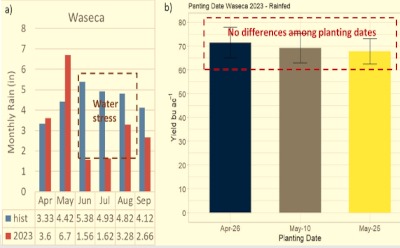By Anibal Cerrudo
Early soybean planting in Minnesota maximizes yield by optimizing resource utilization. However, risks that lead to poor stands and situations that require replanting must be managed. In addition, water stress can impact planting date effects, emphasizing the need for informed decisions to optimize yield.
This report aims to explore the significance of planting dates in determining soybean yield among Minnesota farmers. Through the presentation of locally generated and modeled data, we seek to underscore the importance of early planting, address the risks associated with replanting, and examine the impact of water stress on planting date decisions.
The Impact of Planting Date on Yield
Research consistently demonstrates that the timing of soybean planting influences soybean yield. Early planting offers a distinct advantage, resulting in higher yields compared to delayed planting. This advantage is attributed to resource capture and utilization.
As planting is delayed from the earliest possible date, the more critical reproductive stages are shortened and exposed to a reduced incident radiation (Figure 1a), resulting in reduced radiation capture. Temperatures during these stages are also lower as we delay planting (Figure 1a) that in turn reduces the efficiency to transform radiation in growth. Consequently, as we delay planting date, both reduced radiation and efficiency in radiation utilization impact crop growth during these critical stages, affecting yield.
To illustrate these concepts, we can use some modeled data for St Paul for the 2000-2023 period in Figure 1b. A progressive yield loss is observed, with reductions ranging from 0.4 bushel per acre per day of planting delay during May to 1.0 bushel per acre per day of planting delay during June. For instance, a 10-day delay in May may result in a yield depression close to 4 bushel per acre, while the same delay in June may lead to a 10 bushel per acre yield depression. In this way, advancing planting dates can increases yield without any extra cost.

Figure 1a (left) Schematic representation of the impact of planting dates on resource capture and utilization. Illustrates how the duration of the reproductive stages (orange) is shortened as the crop is exposed to lowered radiation and temperature as planting is delayed throughout the season, departing from the earliest planting date. 1b. (right) Relationship between modeled potential soybean yield (yield under no water, nutrient, or pest limitations) and planting date for St. Paul, MN. Cropgro (DSSAT) validated with local data (mean absolute error=2.4 bu ac-1) was used to simulate planting date effect from 2000 to 2023; the average (line) and the standard deviation (shadow) are presented. During May, each day of delay resulted in an average of 0.4 bu per acre per day of planting delay; this yield depression increased to 1 bu per acre per day during June.
Considerations for risk management
While early planting offers yield advantages, it's crucial to assess potential risks such as frost events or adverse soil conditions affecting crop establishment, which may necessitate replanting. For instance, advancing the planting date by a week in early May (Figure 2) could lead to almost a 3 bu/ac yield increase (7 days x 0.4 bu/ac day = 2.8 bu/ac). However, if replanting is required due to poor stand conditions and occurs three weeks after planting, a yield loss close to 6 bu/ac is expected compared to a farmer who did not advance the planting date (14 days x 0.4 bu/ac day = 5.6 bu/ac). Replanting also incurs additional costs, including seed and labor expenses, which may amount to up to 7 bu/ac. Thus, while early planting is advantageous, it's crucial to mitigate the risk of conditions that lead to poor stands and replanting to avoid a yield loss that can even exceed the initial intended advantage.

| Figure 2. Hypothetical effect of different planting/replanting scenarios on yield, considering the expected depression in yield estimated for Figure 1b of 0.4 bushels per acre per day of delay in planting date during May. |
Addressing water stress
It is important to acknowledge that planting date effects may vary under conditions of water stress. While radiation and temperature play pivotal roles in yield determination in the absence of stress, water stress emerges as a crucial factor under low water availability conditions. To illustrate this point, we present data from Waseca's 2023 season, characterized by reduced rainfall and evident water stress. Despite variation in planting dates, no significant differences in yield were observed, highlighting the overriding influence of water availability on soybean yield under such environmental conditions.

Figure 3a. (left) ) Historic (hist) and 2023 season monthly rains at Waseca, indicating a relatively low amount of precipitation for June, July, and August in 2023,which is in accordance with the observed water stress symptoms by soybean. 3b. (right) Soybean yield for three planting dates at Waseca (Southern Research and Outreach Center) during 2023. Each bar shows the average of four replications. No differences in soybean yield were found among planting dates
Source : umn.edu